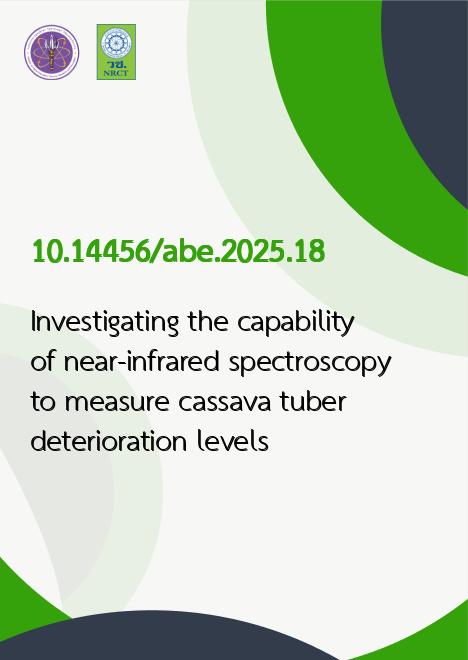
|
Investigating the capability of near-infrared spectroscopy to measure cassava tuber deterioration levels |
|---|---|
| รหัสดีโอไอ | |
| Creator | Kanvisit Maraphum |
| Title | Investigating the capability of near-infrared spectroscopy to measure cassava tuber deterioration levels |
| Contributor | Jetsada Posom, Siriwan Thomchin, Taichak Nawachai |
| Publisher | Faculty of Engineering, Khon Kaen University |
| Publication Year | 2568 |
| Journal Title | Agricultural and Biological Engineering |
| Journal Vol. | 2 |
| Journal No. | 4 |
| Page no. | 127-136 |
| Keyword | Cassava, Starch content, Dry matter content, Storage, Deterioration |
| URL Website | https://ph04.tci-thaijo.org/index.php/abe |
| Website title | ThaiJo |
| ISSN | 3056-932X (Online) |
| Abstract | This research aims to develop a model for assessing the deterioration level of cassava roots using near-infrared spectroscopy techniques. The study focuses on evaluating the capability of measuring the deterioration level of cassava roots from the Kasetsart 50 variety, harvested from a cassava field at ages of 9 and 12 months after planting, with a total of 42 roots. Additionally, samples were collected from a cassava field in Dunsat Subdistrict, Kranuan District, Khon Kaen Province, at the age of 10 months, totaling 21 roots. The model was constructed by scanning within the wavelength range of 500-1100 nm, using a detector installed on the side and connected to the Mini-NIR spectrometer. The data obtained were analyzed for physical and chemical properties over different storage periods. The analysis included brightness (L), color intensity, dry matter content (DMC), and starch content (SC) using ANOVA test. Significant differences were found at a confidence level of 95% for L, a*, b*, SC, and DMC, while the color intensity b* showed no significant difference. The spectroscopic measurements with the NIR Spectrometer indicated important changes in properties. In developing the K-Nearest Neighbors (KNN) model, it was found that using the raw spectrum yielded the highest accuracy at 69%, reflecting the ability to predict the deterioration of cassava roots in the future. This study not only contributes significantly to the knowledge of cassava root deterioration but also provides a recommendation for developing techniques to assess the quality and freshness of agricultural products in the future. |